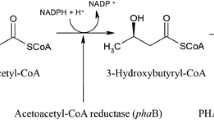Abstract
Pseudomonas denitrificans is a gram-negative bacterium that can produce vitamin B12 under aerobic conditions. Recently, recombinant strains of P. denitrificans overexpressing a vitamin B12-dependent glycerol dehydratase (DhaB) were developed to produce 3-hydroxypropionic acid (3-HP) from glycerol. The recombinant P. denitrificans could produce 3-HP successfully under aerobic conditions without an exogenous supply of vitamin B12, but the 3-HP produced disappeared during extended cultivation due to the 3-HP degradation activity in this strain. This study developed mutant strains of P. denitrificans that do not degrade 3-HP. The following eight candidate enzymes, which might be responsible for 3-HP degradation, were selected, cloned, and studied for their activity in Escherichia coli: four (putative) 3-hydroxyisobutyrate dehydrogenases (3HIBDH), a putative 3-HP dehydrogenase (3HPDH), an alcohol dehydrogenase (ADH), and two choline dehydrogenases (CHDH). Among them, 3HIBDHI, 3HIBDHIV, and 3HPDH exhibited 3-HP degrading activity when expressed heterologously in E. coli. When 3hpdh alone or along with 3hibdhIV were disrupted from P. denitrificans, the mutant P. denitrificans exhibited greatly reduced 3-HP degradation activity that could not grow on 3-HP as the sole carbon and energy source. When the double mutant P. denitrificans Δ3hpdhΔ3hibdhIV was transformed with DhaB, an improved 3-HP yield (0.78 mol/mol) compared to that of the wild-type counterpart (0.45 mol/mol) was obtained from a 24-h flask culture. This study indicates that 3hpdh and 3hibdhIV (to a lesser extent) are mainly responsible for 3-HP degradation in P. denitrificans and their deletion can prevent 3-HP degradation during its production by recombinant P. denitrificans.






Similar content being viewed by others
References
Alber BE, Fuchs G (2002) Propionyl-coenzyme A synthase from Chloroflexus aurantiacus, a key enzyme of the 3-hydroxypropionate cycle for autotrophic CO2 fixation. J Biol chem 277:12137–12143
Ainala SK, Somasundar A, Park S (2013) Complete genome sequence of Pseudomonas denitrificans ATCC 13867. Gen Announ 1(3):e00257–13. doi:10.1128/genomeA.00257-13
Ashok S, Raj SM, Rathnasingh C, Park S (2011) Development of recombinant Klebsiella pneumoniae ΔdhaT strain for the co-production of 3-hydroxypropionic acid and 1,3-propanediol from glycerol. Appl Microbiol Biotechnol 90(4):1253–1265
Ashok S, Sankaranarayanan M, Ko Y, Jae KE, Aniala SK, Vinod K, Park S (2012) Production of 3-hydroxypropionic acid from glycerol by recombinant Klebsiella pneumoniae ΔdhaT ΔyqhD which can produce vitamin B12 naturally. Biotechnol Bioeng 110(2):511–524
Arasu MV, Sarkar R, Sekar BS, Kumar V, Rathnasingh C, Choi J, Song H, Seung D, Park S (2013) Isolation of a novel Pseudomonas species SP2 producing vitamin B12 under aerobic condition. Biotech Bioprocess Eng 18(1):43–51
Giovalnelli J, Stumpf PK (1958) Fat metabolism in higher plants. X. Modified β oxidation of propionate by peanut mitochondria. J Biol Chem 231:411–426
Hall RH, Stern ES (1950) Acid-catalysed hydration of acrylaldehyde: kinetics of the reaction and isolation of β-hydroxypropaldehyde. J Chem Soc 490–498
Kumar V, Ashok S, Park S (2013) Recent advances in biological production of 3-hydroxypropionic acid. Biotecnol Adv 31(6):945–961
Paulsen IT, Press CM, Ravel J, Kobayashi DY, Myers GSA, Mavrodi DV, DeBoy RT, Seshadri R, Ren Q, Madupu R, Dodson RJ, Durkin AS, Brinkac LM, Daugherty SC, Sullivan SA, Rosovitz MJ, Gwinn ML, Zhou L, Schneider DJ, Cartinhour SW, Nelson WC, Weidman J, Watkins K, Tran K, Khouri H, Pierson EA, Pierson LS III, Thomashow LS, Loper JE (2005) Complete genome sequence of the plant commensal Pseudomonas fluorescens Pf-5. Nat Biotechnol 23:873–878
Paster M, Pellegrino JL, Carole TM (2003) Industrial bioproducts: today and tomorrow. US DOE report. http://www.brdisolutions.com/pdfs/BioProducts. Opportunities Report Final.pdf
Raj SM, Rathnasingh C, Jo JE, Park S (2008) Production of 3-hydroxypropionic acid from glycerol by a novel recombinant Escherichia coli BL21 strain. Process Biochem 43(12):1440–1446
Rathnasingh C, Raj SM, Jo JE, Park S (2009) Development and evaluation of efficient recombinant Escherichia coli strains for the production of 3-hydroxypropionic acid from glycerol. Biotechnol Bioeng 104(4):729–739
Rendina G, Coon MJ (1957) Enzymatic hydrolysis of coenzyme A thiol esters of β-hydroxypropionic and β-hydroxyisobutyric acids. J Biol Chem 225:523–534
Sambrook J, Russell D (2001) Molecular cloning: a laboratory manual, 3rd edn. Cold Spring Harbor Laboratory Press, New York
Schneider K, Asao M, Carter MS, Alber BE (2012) Rhodobacter sphaeroides uses a reductive route via propionyl coenzyme A to assimilate 3-hydroxypropionate. J Bacteriol 194(2):225–232
Todd JD, Curson AR, Nikolaidou-Katsaraidou N, Brearley CA, Watmough NJ, Chan Y, Page PC, Sun L, Johnston AW (2010) Molecular dissection of bacterial acrylate catabolism-unexpected links with dimethylsulfoniopropionate catabolism and dimethyl sulfide production. Environ Microbiol 12(2):327–343
West SE, Schweizer HP, Dall C, Sample AK, Runyen-Janecky LJ (1994) Construction of improved Escherichia-Pseudomonas shuttle vectors derived from pUC18/19 and sequence of the region required for their replication in Pseudomonas aeruginosa. Gene 148(1):81–86
Yim SH, Kim TM, Hu HJ, Kim JH, Kim BJ, Lee JY, Han BG, Shin SH, Jung SH, Chung YJ (2010) Copy number variations in East-Asian population and their evolutionary and functional implications. Hum Mol Genet 19:1001–1008
Zhou S, Catherine C, Rathnasingh C, Somasundar A, Park S (2013a) Production of 3-hydroxypropionic acid from glycerol by recombinant Pseudomonas denitrificans. Biotechnol Bioeng. doi:10.1002/bit.24980
Zhou S, Mohan Raj S, Ashok S, Edwardraja S, Lee SG, Park S (2013b) Cloning, expression and characterization of 3-hydroxyisobutyrate dehydrogenase from Pseudomonas denitrificans ATCC 13867. PLoS ONE 8(5):e62666. doi:10.1371/journal.pone.0062666
Acknowledgement
This study was supported financially by the Korean Ministry of Education, Science, and Technology through the Advanced Biomass R&D Center (ABC; grant no. 2010-0029799), KAIST, Korea. In addition, the authors are grateful for the financial assistance provided by the BK21 Plus Program for Advanced Chemical Technology at Pusan National University.
Author information
Authors and Affiliations
Corresponding author
Rights and permissions
About this article
Cite this article
Zhou, S., Ashok, S., Ko, Y. et al. Development of a deletion mutant of Pseudomonas denitrificans that does not degrade 3-hydroxypropionic acid. Appl Microbiol Biotechnol 98, 4389–4398 (2014). https://doi.org/10.1007/s00253-014-5562-5
Received:
Revised:
Accepted:
Published:
Issue Date:
DOI: https://doi.org/10.1007/s00253-014-5562-5




